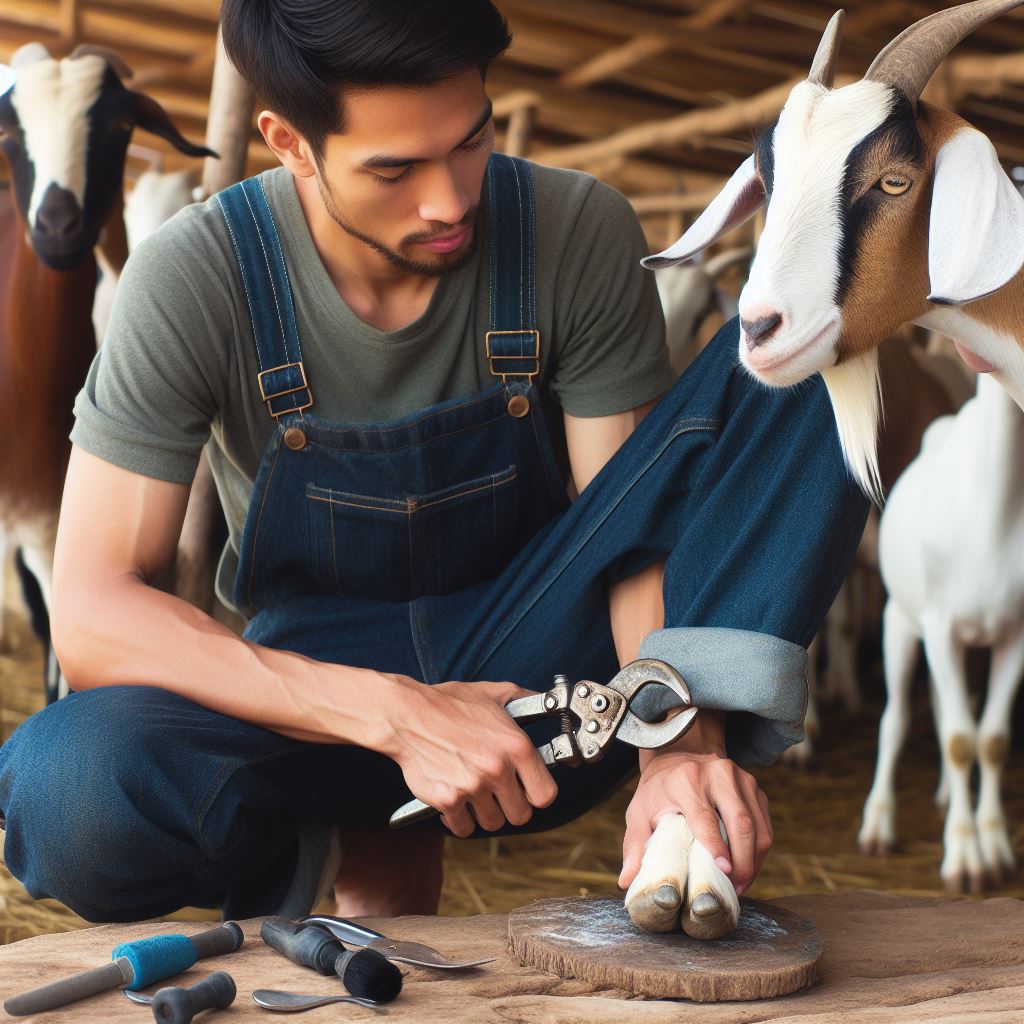Goat Hoof Trimming: A Step-by-Step
Last Updated on February 5, 2024
Introduction
Goat hoof trimming is of utmost importance as it is crucial for their overall health and well-being.
Regular hoof maintenance provides several benefits like reducing the risk of lameness and improving mobility.
In this blog post, we will provide a brief overview of the step-by-step process for goat hoof trimming.
Importance of goat hoof trimming
Goats, like other animals, rely on their hooves for locomotion and support.
Neglecting hoof care can lead to various health issues such as infections and discomfort.
Regular trimming helps prevent hoof overgrowth and maintain the correct hoof structure.
Benefits of regular hoof maintenance
Properly trimmed hooves promote good blood circulation and prevent painful pressure points.
Regular inspections lower the risk of hoof related diseases and provide early detection of potential issues.
Trimming also ensures a balanced weight distribution, reducing strain on joints and bones.
Brief overview of the step-by-step process
- Preparation: Gather necessary tools such as a hoof trimmer, gloves, and a clean working area.
- Secure the goat: Safely restrain the goat either by tying or using a secure stand.
- Cleaning: Clean the hooves to remove dirt, debris, and manure for better visibility.
- Trimming: Gradually trim excess hoof growth to ensure proper length and shape.
- Inspect and treat: Examine the hooves for any abnormalities or signs of infections.
- Post-trimming care: Apply antiseptic or hoof dressing to promote healing and prevent infections.
In essence, goat hoof trimming is vital for their well-being, providing multiple benefits and maintaining overall health.
Understanding the step-by-step process plays an essential role in ensuring proper hoof care for your goats.
Read: Kidding in Goats: Managing Births
Preparations before hoof trimming
Before starting the actual hoof trimming process, it is essential to prepare adequately.
This ensures the safety and comfort of both the goat and the person performing the trimming.
Gather necessary tools and equipment
The first step is to gather all the necessary tools and equipment.
These include a hoof trimmer, hoof pick, hoof rasp, gloves, and a halter and lead rope for restraining the goat.
By having all the tools within reach, you can efficiently perform the hoof trimming without any interruptions or delays.
Secure and restrain the goat properly
Properly securing and restraining the goat is vital for a successful hoof trimming session.
Use a sturdy halter to secure the goat’s head and prevent it from moving or escaping during the process.
Attach a lead rope to the halter and tie it to a secure post or fence.
This will ensure that the goat stays in place and doesn’t pose any safety risks to itself or the trimmer.
Create a safe and clean environment for hoof trimming
Creating a safe and clean environment is crucial for the well-being of the goat.
Ensure that the area where the trimming will take place is well-lit and has ample space for the goat to stand comfortably.
Clear any debris or dirt from the ground to minimize the risk of slips or falls during the procedure.
A clean and organized environment also makes it easier to handle and inspect the goat’s hooves.
It is also important to choose a quiet and calm location for hoof trimming.
Goats are sensitive animals, and a stressful environment can make the process more difficult for both the goat and the trimmer.
By following these preparations, you are setting the stage for a successful and stress-free hoof trimming session.
It is essential to prioritize the safety and comfort of the goat while ensuring that you have all the necessary tools and equipment at hand.
Remember to always approach the goat with patience and care to establish a trusting relationship throughout the trimming process.
With proper preparations, you can maintain the health and well-being of your goat’s hooves effectively.
Read: Managing Goat Health: Disease & Prevention
Step-by-step guide to goat hoof trimming
Step 1: Inspect the hoof condition
- Check for signs of overgrowth or hoof disease.
- Identify any abnormalities or injuries.
Before starting the actual process of goat hoof trimming, it is crucial to inspect the condition of the hooves.
This step allows you to assess the overall health and identify any issues that may require attention.
Step 2: Clean the hooves thoroughly
- Remove any dirt, debris, or manure.
- Use a mild antiseptic solution to sanitize the hooves.
Cleanliness is essential for effective hoof trimming.
By removing any dirt, debris, or manure, you ensure a clear view of the hooves.
Additionally, using a mild antiseptic solution helps prevent infections and promotes hoof health.
Step 3: Trim the excess length
- Use appropriate trimming tools (e.g., hoof shears, rasp).
- Trim the hoof walls evenly and avoid cutting into the sensitive areas.
Trimming the hooves is the core of goat hoof maintenance.
Using the right tools, such as hoof shears or a rasp, carefully remove the excess length.
It is crucial to maintain an even trim and avoid cutting into the sensitive areas, as this can cause pain and potential complications.
Step 4: Address any hoof issues or abnormalities
- Treat hoof disease or infections if detected.
- Consult a veterinarian for serious cases.
While trimming, it is essential to observe the hooves for any signs of disease or abnormalities.
If any issues are detected, promptly treat them with appropriate medications or consult a veterinarian for professional advice, especially in severe cases.
Step 5: Evaluate goat’s comfort post-trimming
- Ensure the goat can walk comfortably on trimmed hooves.
- Monitor for any signs of lingering pain or discomfort.
After the trimming process, take the time to evaluate the goat’s comfort level.
Ensure that the goat can walk comfortably on its trimmed hooves, indicating a proper trim.
Additionally, monitor the goat for any signs of lingering pain or discomfort, which might require further attention.
Read: Green Goat Farming Methods
Best practices for maintaining healthy hooves
When it comes to maintaining healthy hooves in goats, following best practices is essential.
This section will discuss the importance of regular hoof trimming, proper nutrition and supplementation, as well as regular hoof cleaning and maintenance.
Regularity of hoof trimming
One key aspect of maintaining healthy hooves in goats is the regularity of hoof trimming.
Goat owners should establish a consistent schedule for trimming to ensure the overall health and well-being of their goats.
Importance of a consistent schedule
A consistent schedule for hoof trimming helps keep the hooves in good condition and prevents overgrowth.
By regularly trimming the hooves, the goat’s weight is evenly distributed, reducing the risk of lameness and other hoof-related issues.
Factors affecting trimming frequency (e.g., terrain, hoof growth rate)
The frequency of hoof trimming can vary depending on factors such as the terrain the goats are kept on and their individual hoof growth rate.
Goats that graze on rocky or abrasive terrains may require more frequent trimming to prevent overgrowth and potential injuries.
Proper nutrition and supplementation
Proper nutrition and supplementation play a crucial role in maintaining healthy hooves in goats.
Providing a balanced diet for strong hoof growth
A balanced diet rich in essential nutrients, vitamins, and minerals is vital for promoting strong hoof growth.
A diet based on high-quality forage, supplemented with grain and minerals, ensures that goats receive the necessary nutrients for healthy hooves.
Recognizing the need for specific minerals (e.g., zinc, copper)
Specific minerals like zinc and copper are essential for hoof health in goats. Z
inc is involved in the formation and maintenance of keratin, a protein found in hooves, while copper is necessary for the development of strong connective tissues.
Recognizing the need for these minerals and providing appropriate supplementation is crucial.
Regular hoof cleaning and maintenance
Regular hoof cleaning and maintenance significantly contribute to the overall health and condition of goat hooves.
Importance of cleanliness to prevent infections
Cleanliness is essential to prevent hoof infections, such as hoof rot and foot scald, which can cause severe pain and lameness.
Regularly cleaning hooves helps remove dirt, debris, and bacteria, reducing the risk of infections and other hoof-related problems.
Checking hooves regularly for issues or abnormalities
Regularly inspecting and checking goat hooves for any issues or abnormalities is crucial for early detection and prompt treatment.
This includes looking for signs of lameness, foot lesions, cracks, or any signs of infection.
Timely intervention can prevent further complications and promote faster recovery.
Overall, maintaining healthy hooves in goats requires adhering to best practices such as regular hoof trimming, proper nutrition and supplementation, and regular hoof cleaning and maintenance.
By following these guidelines, goat owners can ensure the long-term health and well-being of their goats.
Read: Fencing Solutions for Sheep and Goats

Conclusion
Recap of the step-by-step guide to goat hoof trimming:
To trim goat hooves, first, gather all the necessary tools such as hoof trimmers, a hoof pick, and a rasp.
Next, secure the goat safely in a pen or trimming stand to prevent injuries.
Then, clean the hooves thoroughly and examine them for any signs of infection or disease.
Carefully trim the overgrown or misshapen part of the hoof, ensuring not to cut into the sensitive tissues.
Finally, use a rasp to smooth the edges of the hoof and provide a proper balance.
The importance of regular hoof maintenance for goat health and well-being:
Regular hoof trimming is essential to prevent various hoof problems in goats, such as overgrowth, cracked hooves, and bacterial infections.
By maintaining proper hoof care, we can ensure that the goats can walk, run, and jump comfortably, leading to overall better health and quality of life.
Encouragement to seek professional assistance if needed
While this step-by-step guide provides a good foundation for goat owners to trim hooves themselves, there may be instances where professional assistance is necessary.
If the goat has severe hoof issues or if you are unsure about the process, it is always advisable to consult a veterinarian or a professional hoof trimmer who can provide expert help.


